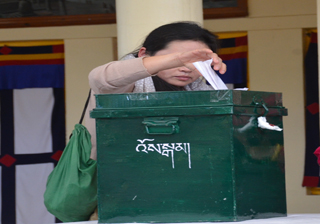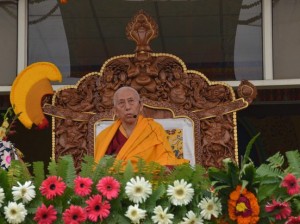His Holiness the Dalai Lama initiated the current democratic process for his people following his flight to India in 1959. He spoke to a large gathering of Tibetans in Bodh Gaya in 1960, asking them to elect their representatives through universal adult suffrage. Despite their lack of knowledge of modern democracy, Tibetans in exile went to the polls and in September that year the first democratically elected Tibetan Parliamentarians took their oath from His Holiness the Dalai Lama.
His Holiness then worked steadily to initiate a modern democratic Parliament-in-Exile for his people, with a Constitution for Future Tibet and an electoral process. In 1991, the Charter for Tibetans in Exile came into being.
The Charter of the Tibetans-in-Exile is the supreme law governing the functions of the Central Tibetan Administration (CTA, or administration of the Tibetan Government-in-Exile). Its functions are carried out by the three pillars of democracy: Judiciary; Legislature and Executive. The Charter incorporates a policy of non-violence, free democracy, equality, respect for human rights, and the promotion of moral values while ensuring the material welfare of the Tibetan people. It also outlines the rights and responsibilities of Tibetans in exile. It provides for equal political rights and economic and social benefits in the exile community, and emphasises the importance of education. Regarding a possible future return to Tibet, the Charter directs the CTA to “maintain a just policy for the achievement of the common goal of Tibet.”
Structure of Parliament
The Tibetan Parliament-in-exile, based in Dharamshala, currently consists of 44 Members of Parliment, or Chitue: ten from the three traditional provinces of Tibet – U-tsang, Dotoe, and Domey – and two members from each of the four schools of Tibetan Buddhism and the Bon faith. In addition, four members are elected by Tibetans living in the West: two from Europe, two from North America and for this next Parliament there will be 45 members with the addition of the new member representing Tibetans living in Australasia. Elections are held every five years and any Tibetan who has reached the age of 18 is entitled to vote. Any Tibetan who has reached the age of 25 has the right to stand for election to Parliament.
The Tibetan Parliament-in-Exile is headed by a Speaker and a Deputy Speaker, who are elected by the members amongst themselves. Two 10- to 15-day sessions of Parliament are held each year. The Sikyong, or Prime Minister, forms a Kashag (Cabinet) by nominating not more than seven Kalons (ministers) who are then approved by Parliament, if needed, by a vote.
The Members of Parliament (MPs) undertake periodic tours to Tibetan settlements to monitor conditions and Parliament also keeps in touch with people through Local Parliaments established in 38 major Tibetan communities. Local Parliaments make laws for their respective communities which are implemented by the respective settlement/welfare officer.
Elections
The election for the post of Sikyong takes place alongside that for the Chitues, or MPs, all Tibetans having the opportunity to vote for Sikyong as well as their MP. People wishing to vote must register in advance of the election. A preliminary election takes place, following which the leading candidates stand for the final election which this year will be held on March 20.
The Election Commission
The CTA has set up the Election Commission (EC) to conduct all Tibetan elections. It has a permanent office in the CTA compound and is headed by the Chief Election Commissioner (CEC). The EC has a two-tier system: the Central Election Commission and Regional Election Offices. It conducts the Tibetan General Elections; elections of Speaker and Deputy Speaker of Parliament and oversees elections of Local Assembly members and officers and members of the Regional Tibetan Freedom Movement and their Presidents.
Chief Election Commissioner
The CEC appointment is made by a vote within Parliament. The current CEC is Sonam Choephel Shosur who has served in this appointment since September 2014 following a career in various Settlement Offices and the Department of Health. For Parliamentary elections, two Additional Election Commissioners are appointed, also by a parliamentary vote.
The Current Election
The current election is sparking huge interest, as well as debate and questions about the election procedures, as the Tibetan people in exile enjoy their democratic right to become involved in the process. They are empowered by social media and access to information, as well as improved education and increasing political awareness, and are entering into debates in Dharamshala and around the world.
The candidates for the final election on March 20 were announced on February 3, with two candidates for the post of Sikyong (). For the Chitue (), election regulations stipulate that twice the number seats for each constituency are shortlisted in addition to the voluntary candidates. They have therefore shortlisted 20 candidates plus one volunteer candidate for Utsang, 20 candidates each for Dotoe and Domey constituencies and four candidates each for the four schools of Tibetan Buddhism and the Bon Religion.
For the Europe, North America, and Australasia (excluding India, Nepal and Bhutan) constituencies, they have shortlisted four candidates each, in addition to two volunteer candidates for North America and one volunteer candidate for Australasia.
Middle Way or Rangzen?
For the first time in the history of the government-in-exile, a radical political perspective has been represented among the contenders for the Sikyong position. Lukar Jam, ex-political prisoner, President of Gu Chu Sum and outspoken advocate of Rangzen, or full independence for Tibet, stood for Sikyong in the preliminary election. Having an individual with a different viewpont involved in the political process is in line with the Dalai Lama’s vision of bringing full democracy to the CTA and opened the door for the Tibetan people to express whether they support independence or autonomy. At its heart, a democratic society is one in which a variety of opinions can be expressed and discussed in order to allow an informed public to make decisions about its leadership.
*Information source: tibet.net
For more on the Election click here





 Print
Print Email
Email